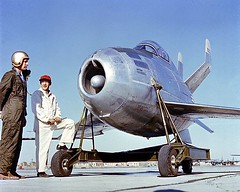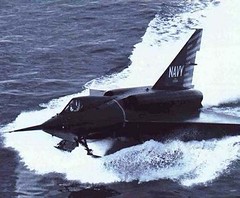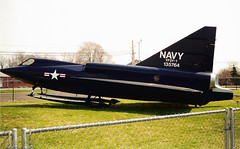Since I have a lot of time on my hands, in waiting rooms and otherwise, I've been reading a lot. I've worked through almost everything in my vast aviation and science-fiction library that I care to re-read, and so I ordered some new books for myself. I have always loved bookstores; when I was a kid, I would head straight for the bookstore, stay there for hours and grumble if I had to do any other shopping. But now it's all online -
Barnes & Noble,
Amazon and others all have smooth-working websites that let you browse inside the book covers a little. And there are plenty of smaller stores online too, with specialized subject matter, like
Hannan's Runway - for modelers and other airplane enthusiasts.
I have two new books from Hannan's, monographs on a few obscure planes from the 1950s. It was the era when the Cold War got into full swing, and the superpowers let the military aviation budgets run wild, with some startling results. It seems as though just about
any cockamamie idea was worth a few zillion dollars and a few prototypes; of course, in those days without computer simulation, that was the only way to find out whether theory could be put into practice. Aviation history of this era is dotted with faded pictures of these orphans, hilarious in hindsight to everyone but the poor test pilots - where they survived...
For example, jet bombers of that era had much longer range than jet fighters. But bombers are vulnerable without fighter escort. Proposal: Stick a tiny, ugly jet fighter
inside the bomber. When the bomber is attacked, release it on a trapeze and let it go off to battle the Commies. Then the jet fighter returns to the bomber IN MIDAIR, latches on again, FOLDS UP and is pulled in. Insane, right? But they did it - this is the XF-85 "Goblin", built to test the "parasite fighter" concept. Its bizarre shape allowed it to fit into the bomb bay of a B-29, but left it severely limited in terms of performance and stability.
One of my new books details the Convair Sea Dart, a supersonic jet fighter...
seaplane. The U.S. Navy opined that runways and air bases were expensive to build and maintain, and even Air Force pilots could land on them. So the "floating base" concept was put forward whereby bombers, cargo planes and even the fighters could land and take off on water, bobbing happily away in any harbor or lake. The Sea Dart - a twin-jet, delta-winged fighter was designed to take off and land ON WATERSKIS - insane, right? But five were built and three actually flown - and they remain, to this day, the only supersonic seaplanes ever built. (The test planes were underpowered, but one of them exceeded the speed of sound in a slight dive.)
As you might guess, they were useless as fighter planes, and practically destroyed themselves on takeoff and landing. I have actually seen two of the surviving examples, this one on display at Willow Grove Naval Air Station near Philadelphia, the other at a museum in San Diego. (Oddly, I saw them on two consecutive days, when I flew out with the Air Force!)
Amazing, that so much money and effort was put into projects like these, with so little return on the investment. Especially in those cases, like the Sea Dart, where test pilots were killed in the flight-test program. But then, the mixture of comedy and tragedy in these machines seems appropriate for the whole Cold War, doesn't it?


